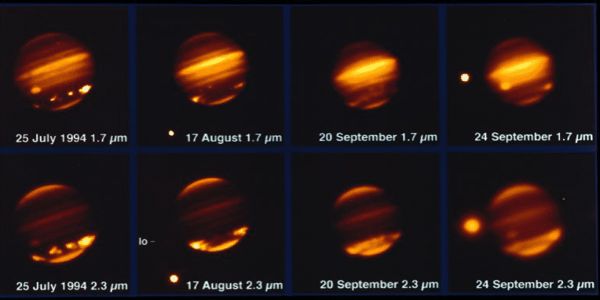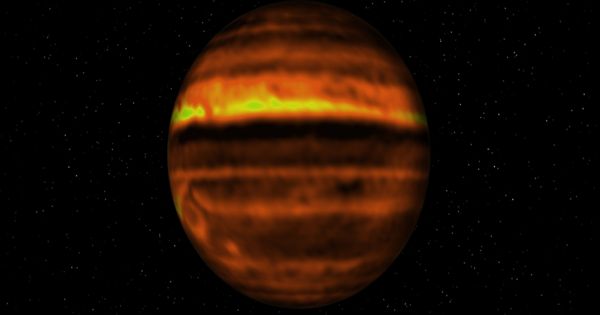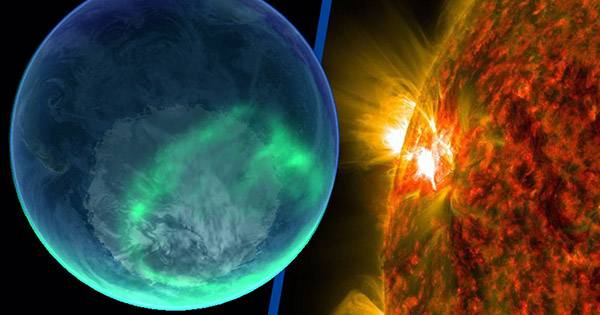Winds in Jupiter’s middle atmosphere have now been directly measured by astronomers. The researchers discovered incredibly powerful winds with speeds of up to 1450 kilometers per hour near Jupiter’s poles by analyzing the aftermath of a comet collision from the 1990s. They could be a ‘one-of-a-kind meteorological beast in our Solar System.’
A team of astronomers has measured winds in Jupiter’s middle atmosphere for the first time using the Atacama Large Millimeter/submillimeter Array (ALMA), in which the European Southern Observatory (ESO) is a partner. The researchers discovered incredibly powerful winds with speeds of up to 1450 kilometers per hour near Jupiter’s poles by analyzing the aftermath of a comet collision from the 1990s. They could be a “unique meteorological beast in our Solar System,” according to the team.
By analyzing the aftermath of a comet collision from the 1990s, the researchers have revealed incredibly powerful winds, with speeds of up to 1450 kilometers an hour, near Jupiter’s poles.
Jupiter is famous for its distinctive red and white bands, which are swirling clouds of moving gas that astronomers use to track winds in Jupiter’s lower atmosphere. Astronomers have also observed aurorae, or vivid glow, near Jupiter’s poles, which appear to be associated with strong winds in the planet’s upper atmosphere. However, until now, researchers had never been able to directly measure wind patterns in the stratosphere, the layer between these two atmospheric layers.
Because of the lack of clouds in this part of the atmosphere, measuring wind speeds in Jupiter’s stratosphere is impossible using cloud-tracking techniques. However, comet Shoemaker-Levy 9 provided astronomers with an alternative measuring tool when it collided with the gas giant in spectacular fashion in 1994. This impact created new molecules in Jupiter’s stratosphere, which have since moved with the winds.
A team of astronomers led by Thibault Cavalié of France’s Laboratoire d’Astrophysique de Bordeaux has now tracked one of these molecules, hydrogen cyanide, to directly measure stratospheric “jets” on Jupiter. The term “jets” is used by scientists to describe narrow bands of wind in the atmosphere, such as Earth’s jet streams.

“The most spectacular result is the presence of strong jets with speeds of up to 400 meters per second, which are located beneath the aurorae near the poles,” Cavalié says. These wind speeds, which are approximately 1450 kilometers per hour, are more than twice the maximum storm speeds reached in Jupiter’s Great Red Spot and more than three times the wind speed measured on Earth’s most powerful tornadoes.
“Our detection suggests that these jets could behave like a giant vortex with a diameter up to four times that of Earth and a height of about 900 kilometers,” explains co-author Bilal Benmahi of the Laboratoire d’Astrophysique de Bordeaux. “A vortex of this size would be a one-of-a-kind meteorological beast in our Solar System,” adds Cavalié.
Astronomers were aware of strong winds near Jupiter’s poles, but not hundreds of kilometers above the focus area of the new study, which was published today in Astronomy & Astrophysics. Previous research predicted that these upper-atmosphere winds would slow down and disappear before reaching the stratosphere. “The new ALMA data tell us the opposite,” Cavalié says, adding that discovering these strong stratospheric winds near Jupiter’s poles was a “real
The researchers used 42 of ALMA’s 66 high-precision antennas, which are located in northern Chile’s Atacama Desert, to study the hydrogen cyanide molecules that have been moving around in Jupiter’s stratosphere since the Shoemaker-Levy 9 impact. They were able to measure the Doppler shift – tiny changes in the frequency of the radiation emitted by molecules – caused by the winds in this region of the planet using the ALMA data.
“By measuring this shift, we were able to deduce the speed of the winds in the same way that one could deduce the speed of a passing train by the change in frequency of the train whistle,” says study co-author Vincent Hue, a planetary scientist at the Southwest Research Institute in the United States.
In addition to the unexpected polar winds, the team used ALMA for the first time to confirm the existence of strong stratospheric winds around the planet’s equator by directly measuring their speed. The jets spotted in this region of the world have average speeds of around 600 kilometers per hour.
The ALMA observations required to track stratospheric winds in Jupiter’s poles and equator took less than 30 minutes. “The high levels of detail we achieved in such a short time really demonstrate the power of the ALMA observations,” says Thomas Greathouse, co-author of the study and a scientist at the Southwest Research Institute in the United States. “Seeing the first direct measurement of these winds astounds me.”
“These ALMA results open a new window for studying Jupiter’s auroral regions, which was really unexpected just a few months ago,” Cavalié says. “They also lay the groundwork for similar yet more extensive measurements to be made by the JUICE mission and its Submillimetre Wave Instrument,” Greathouse adds, referring to the European Space Agency’s Jupiter ICy moons Explorer, which is set to launch into space next year.
ESO’s ground-based Extremely Large Telescope (ELT), which is expected to make its first observations later this decade, will also investigate Jupiter. The telescope will be able to make highly detailed observations of Jupiter’s aurorae, providing us with new information about the planet’s atmosphere.
















